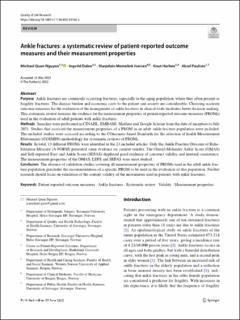| dc.contributor.author | Nguyen, Michael Quan | |
| dc.contributor.author | Dalen, Ingvild | |
| dc.contributor.author | Iversen, Marjolein Memelink | |
| dc.contributor.author | Harboe, Knut | |
| dc.contributor.author | Paulsen, Aksel | |
| dc.date.accessioned | 2022-06-28T07:14:50Z | |
| dc.date.available | 2022-06-28T07:14:50Z | |
| dc.date.created | 2022-06-19T22:35:39Z | |
| dc.date.issued | 2022 | |
| dc.identifier.issn | 0962-9343 | |
| dc.identifier.uri | https://hdl.handle.net/11250/3001191 | |
| dc.description.abstract | Purpose
Ankle fractures are commonly occurring fractures, especially in the aging population, where they often present as fragility fractures. The disease burden and economic costs to the patient and society are considerable. Choosing accurate outcome measures for the evaluation of the management of ankle fractures in clinical trials facilitates better decision-making. This systematic review assesses the evidence for the measurement properties of patient-reported outcome measures (PROMs) used in the evaluation of adult patients with ankle fractures.
Methods
Searches were performed in CINAHL, EMBASE, Medline and Google Scholar from the date of inception to July 2021. Studies that assessed the measurement properties of a PROM in an adult ankle fracture population were included. The included studies were assessed according to the COnsensus-based Standards for the selection of health Measurement INstruments (COSMIN) methodology for systematic reviews of PROMs.
Results
In total, 13 different PROMs were identified in the 23 included articles. Only the Ankle Fracture Outcome of Rehabilitation Measure (A-FORM) presented some evidence on content validity. The Olerud-Molander Ankle Score (OMAS) and Self-reported Foot and Ankle Score (SEFAS) displayed good evidence of construct validity and internal consistency. The measurement properties of the OMAS, LEFS and SEFAS were most studied.
Conclusion
The absence of validation studies covering all measurement properties of PROMs used in the adult ankle fracture population precludes the recommendation of a specific PROM to be used in the evaluation of this population. Further research should focus on validation of the content validity of the instruments used in patients with ankle fractures. | en_US |
| dc.language.iso | eng | en_US |
| dc.publisher | Springer | en_US |
| dc.rights | Navngivelse 4.0 Internasjonal | * |
| dc.rights.uri | http://creativecommons.org/licenses/by/4.0/deed.no | * |
| dc.title | Ankle fractures: a systematic review of patient‑reported outcome measures and their measurement properties | en_US |
| dc.type | Journal article | en_US |
| dc.type | Peer reviewed | en_US |
| dc.description.version | publishedVersion | en_US |
| dc.rights.holder | Copyright The Author(s) 2022 | en_US |
| cristin.ispublished | true | |
| cristin.fulltext | original | |
| cristin.qualitycode | 2 | |
| dc.identifier.doi | 10.1007/s11136-022-03166-3 | |
| dc.identifier.cristin | 2033203 | |
| dc.source.journal | Quality of Life Research | en_US |
| dc.identifier.citation | Quality of Life Research, 2022. | en_US |

